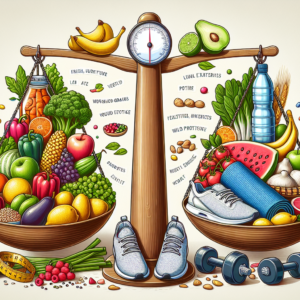Are you tired of trying endless diets and exercise regimes without seeing any real results? If so, then you’ve come to the right place. In this article, we’re going to explore the one question that’s on everyone’s mind: what is the fastest way to lose fat? Say goodbye to confusing and time-consuming strategies – we’ll break down the most effective methods that will help you shed those extra pounds and achieve your desired weight in no time. So, let’s get started on your journey to a healthier and happier you!

Understanding Fat Loss
Definition of Fat Loss
Fat loss refers to the process of reducing body fat while preserving muscle mass. It involves the body’s ability to break down and utilize stored fat as a source of energy.
Different Types of Fat
There are two main types of fat in the body: subcutaneous fat and visceral fat. Subcutaneous fat is found just beneath the skin and is responsible for the soft, pinchable fat that we can see and feel. Visceral fat, on the other hand, is stored deep within the abdominal cavity and surrounds vital organs. Excess visceral fat is more concerning as it is linked to various health problems, including heart disease and diabetes.
Dangers of Excess Body Fat
Having an excessive amount of body fat can significantly increase the risk of developing numerous health conditions, including heart disease, type 2 diabetes, high blood pressure, stroke, certain cancers, and sleep apnea. It also puts additional stress on the joints and can lead to mobility issues and discomfort.
Factors Affecting Fat Loss
Metabolism and Energy Balance
Your metabolism plays a crucial role in fat loss. The rate at which your body burns calories, known as the metabolic rate, varies from person to person. Factors such as age, gender, body composition, and activity level influence metabolic rate. To lose fat, you need to create a caloric deficit by consuming fewer calories than your body needs. This forces your body to tap into stored fat for energy.
Genetics and Body Composition
Genetics can influence aspects related to fat loss, such as metabolic rate, fat distribution, and muscle mass. However, it’s important to note that genetics are not the sole determinants of fat loss. Body composition, which refers to the proportion of muscle, fat, and other tissues in your body, also plays a significant role. Increasing muscle mass can help enhance fat loss due to its higher metabolic rate.
Lifestyle and Eating Habits
Your lifestyle and eating habits have a profound impact on your ability to lose fat. Regular exercise, adequate sleep, and stress management are all essential components of a healthy lifestyle that supports fat loss. Additionally, adopting sustainable eating habits, such as mindful eating, portion control, and choosing nutritious foods over processed ones, can greatly contribute to achieving your fat loss goals.
Creating a Caloric Deficit
Importance of Caloric Deficit
Creating a caloric deficit is essential for fat loss. When you consume fewer calories than your body needs, it breaks down stored fat to make up the energy deficit. This leads to gradual fat loss over time. It’s important, however, to create a moderate caloric deficit to avoid excessive muscle loss and metabolic slowdown.
Determining Caloric Needs
To create a caloric deficit, you need to determine your daily energy needs. This is influenced by factors such as your basal metabolic rate (BMR), activity level, and goals. Calculating your BMR using formulas like the Harris-Benedict equation can give you an estimate of the calories your body needs at rest. From there, you can adjust your caloric intake based on your activity level and fat loss goals.
Tracking and Monitoring Caloric Intake
Tracking and monitoring your caloric intake is crucial for creating and maintaining a caloric deficit. This can be done by keeping a food diary or using mobile apps specifically designed for calorie tracking. By logging your meals and snacks, you gain a better understanding of your eating patterns and can make adjustments as needed to ensure you stay within your caloric target.
Choosing the Right Diet
Popular Fat Loss Diets
There are numerous fat loss diets available, each with its own approach and macronutrient distribution. Some popular diets include low-carb, ketogenic, intermittent fasting, and Mediterranean diets. These diets often restrict certain food groups or manipulate macronutrient intake to create a calorie deficit.
Effectiveness and Sustainability
When choosing a fat loss diet, it’s important to consider both its effectiveness and long-term sustainability. While some diets may offer rapid weight loss initially, they may not be sustainable in the long run. It’s important to choose a diet that you can maintain for an extended period, as consistency is key for achieving and maintaining fat loss.
Considerations for Personal Preferences
Personal preferences, such as food preferences, cultural influences, and dietary restrictions, should also be taken into account when choosing a fat loss diet. Adhering to a diet that aligns with your preferences increases the likelihood of long-term success and adherence.

Smart Food Choices
Importance of Nutrient-Dense Foods
When aiming for fat loss, it’s essential to focus on consuming nutrient-dense foods. These are foods that provide a high amount of essential nutrients, such as vitamins, minerals, and antioxidants, relative to their calorie content. Nutrient-dense foods include fruits, vegetables, lean proteins, whole grains, and healthy fats.
Prioritizing Protein Intake
Protein plays a crucial role in fat loss as it helps preserve lean muscle mass, which is important for maintaining a healthy metabolism. It also promotes feelings of fullness and satiety, reducing the likelihood of overeating. Including protein-rich foods such as lean meats, poultry, fish, eggs, legumes, and dairy products in your diet can aid in fat loss.
Fiber and Healthy Fats for Satiety
Fiber-rich foods and healthy fats can also contribute to fat loss by promoting feelings of fullness and delaying hunger. Foods such as fruits, vegetables, whole grains, nuts, and seeds are excellent sources of both fiber and healthy fats. Including these foods in your meals and snacks can help you stay satisfied while reducing overall calorie intake.
Incorporating Exercise
Effects of Exercise on Fat Loss
Exercise is a crucial component of any fat loss program. It not only helps burn calories but also improves overall body composition by increasing muscle mass and reducing fat mass. Additionally, exercise can elevate your metabolic rate, leading to increased calorie burn even at rest.
Optimal Exercise Modalities
To maximize fat loss, a combination of cardiovascular exercise and resistance training is recommended. Cardiovascular activities, such as running, cycling, or swimming, help burn calories and improve cardiovascular health. Resistance training, which includes weightlifting and bodyweight exercises, helps build lean muscle mass, increasing your metabolic rate.
Combining Cardiovascular and Resistance Training
To achieve optimal fat loss, it’s important to find a balance between cardiovascular exercise and resistance training. This could involve engaging in cardio sessions a few times a week and incorporating resistance training exercises on alternate days. By combining both modalities, you can maximize fat loss and improve overall body composition.
Targeted Fat Loss Myth
Understanding Spot Reduction
Spot reduction refers to the notion that you can selectively reduce fat in specific areas of your body through targeted exercises or treatments. However, research has consistently shown that spot reduction is a myth. Fat loss occurs throughout the body in a systemic manner and cannot be targeted to specific areas.
The Science Behind Fat Distribution
The distribution of body fat is influenced by genetics, hormonal factors, and overall body composition. Men tend to carry more fat in their abdominal region, while women typically have more fat in the hips, thighs, and buttocks. Understanding that fat loss is a whole-body process can help dispel the misconception of spot reduction.
Achieving Overall Fat Loss
To achieve overall fat loss, it’s important to focus on creating a caloric deficit through a combination of diet and exercise. While certain exercises may help strengthen specific muscle groups, they will not specifically burn fat in those areas. By prioritizing overall fat loss, you can eventually reduce fat in target areas as well.
Importance of Sleep and Stress Management
Impact of Sleep on Fat Loss
Adequate sleep is crucial for effective fat loss. Lack of sleep disrupts hormonal balance, leading to increased hunger and cravings, decreased metabolism, and impaired insulin sensitivity. Aim for seven to nine hours of quality sleep each night to support your fat loss journey.
Stress and Hormonal Imbalances
Chronic stress can negatively impact fat loss efforts. When stress levels are high, the body releases cortisol, a stress hormone that can promote fat storage, especially in the abdominal region. Incorporating stress management techniques such as meditation, deep breathing exercises, and regular physical activity can help minimize the negative effects of stress on fat loss.
Strategies for Better Sleep and Stress Reduction
To improve sleep quality and reduce stress, establish a regular sleep routine by going to bed and waking up at consistent times. Create a relaxing sleep environment, limit exposure to screens before bed, and engage in relaxation techniques. Additionally, find healthy outlets to manage stress, such as regular exercise, spending time in nature, and connecting with loved ones.
Supplements and Fat Loss
Do Supplements Aid Fat Loss?
While supplements may be marketed as miracle fat loss solutions, they are not a magic bullet for achieving your goals. Some supplements, however, can support fat loss efforts when combined with a balanced diet and regular exercise. It’s important to note that supplements should not replace healthy lifestyle habits and should be used under the guidance of a healthcare professional.
Evidence-Based Supplements
Certain supplements have been shown to have some potential benefits for fat loss. These include caffeine, green tea extract, conjugated linoleic acid (CLA), and forskolin. These supplements may help increase metabolism, improve fat oxidation, and enhance exercise performance. Remember, though, that their effects may vary from person to person.
Supplement Safety and Potential Side Effects
Before taking any supplements, it’s important to consider their safety and potential side effects. Some supplements can interact with medications or have adverse effects on certain individuals. It’s crucial to consult with a healthcare professional or registered dietitian before incorporating any supplements into your fat loss regimen.
Building Sustainable Habits
Long-Term Approach to Fat Loss
Fat loss should be approached as a long-term journey rather than a quick fix. Rapid weight loss methods often lead to weight regain over time. Instead, focus on making sustainable lifestyle changes that promote overall health and well-being. Consistency and patience are key when it comes to achieving and maintaining fat loss.
Emphasizing Behavior Change
To sustain fat loss, it’s important to address the underlying behaviors that contribute to weight gain in the first place. This involves recognizing and modifying unhealthy habits, such as emotional eating or excessive snacking, and replacing them with healthier alternatives. By focusing on behavior change, you can develop sustainable habits that support long-term fat loss.
Setting Realistic Goals and Monitoring Progress
Setting realistic goals is crucial for staying motivated and maintaining fat loss progress. Break down larger goals into smaller, attainable milestones to celebrate along the way. Regularly monitoring your progress, whether through body measurements or how your clothes fit, can provide valuable feedback and keep you accountable on your fat loss journey.
In summary, fat loss is a complex process influenced by various factors including metabolism, genetics, and lifestyle. By creating a caloric deficit, making smart food choices, incorporating exercise, managing stress and sleep, and building sustainable habits, you can achieve and maintain fat loss. Remember, everyone’s journey is unique, so finding an approach that suits your preferences and needs is key. Stay consistent, be patient, and celebrate progress along the way to ultimately achieve your fat loss goals.



